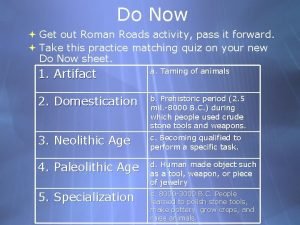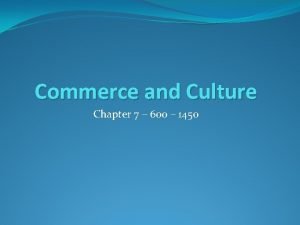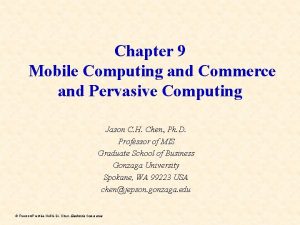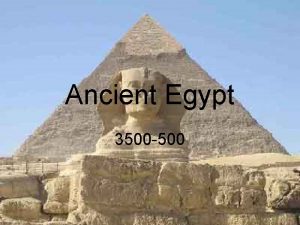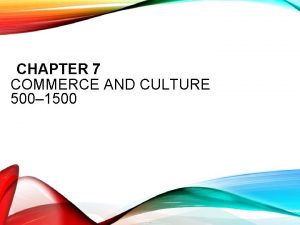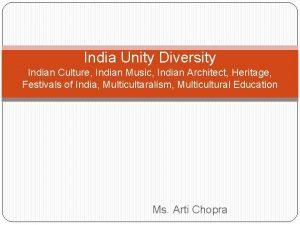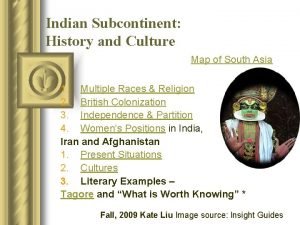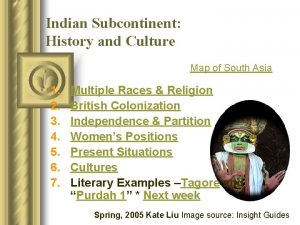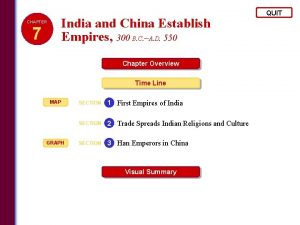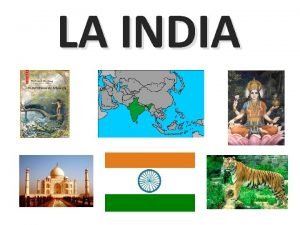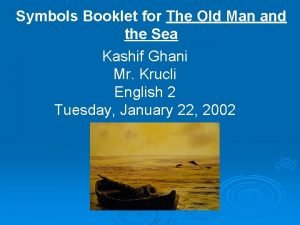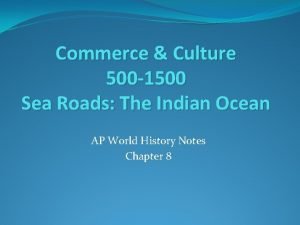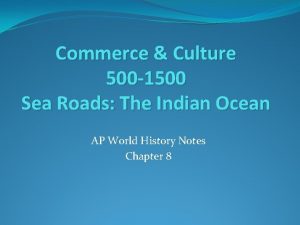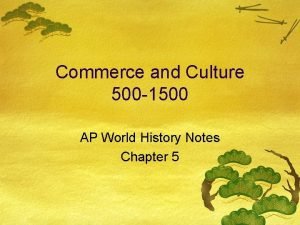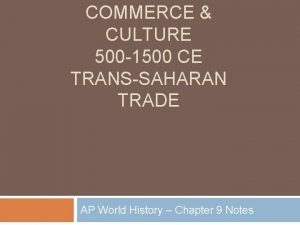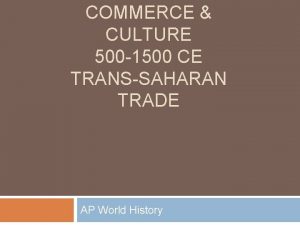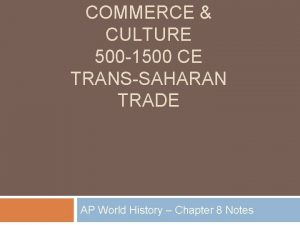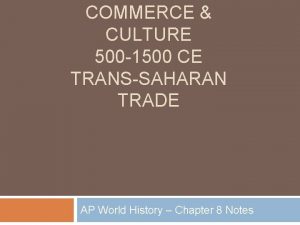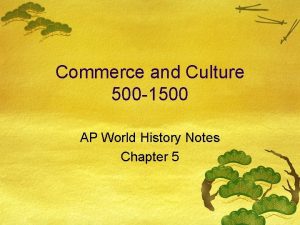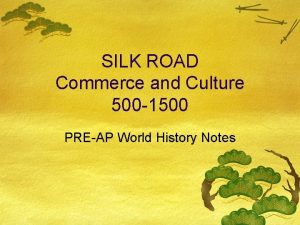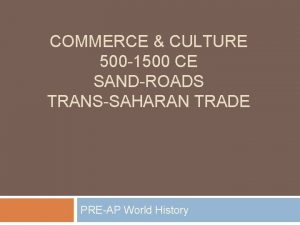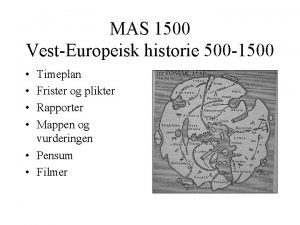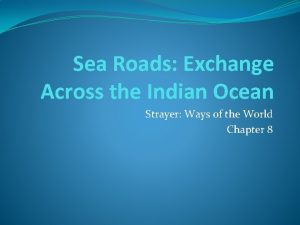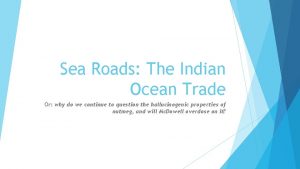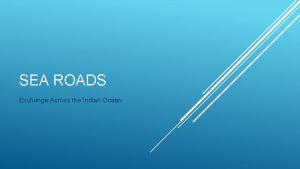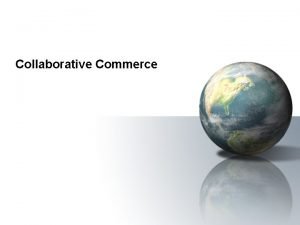Commerce Culture 500 1500 Sea Roads The Indian






















- Slides: 22

Commerce & Culture 500 -1500 Sea Roads: The Indian Ocean AP World History Notes Chapter 8

Sea Exchange �Nothing new �Begins with Mediterranean Sea trade �Participants = Phoenicians, Greeks, Romans �Italian city of Venice = major center of commerce

Sea Exchange �Begins with Red Sea trade �Participants = Egyptians, Phoenicians, Greeks, Romans, Africans �Alexandria = major port and city of commerce

Indian Ocean Exchange

Indian Ocean Exchange �Like the Silk Roads, trade grew because of: �Environmental and cultural diversities in each region �Desire for goods not available at home �Same goods traded from each region as on the Silk Roads �Ex: silk and porcelain from China �Ex: ivory and gold from the African coast �Unlike the Silk Roads: transportation costs much lower �Ships could carry much more at one time than camels �Sea Roads carried more bulk and staple goods not just luxury items like on the Silk Roads

Monsoons �Made Indian Ocean exchange possible �Monsoons = alternating wind currents �Blow predictably eastward in summer months �Blow predictably westward in winter months

Indian Ocean Exchange �Not between countries �Not between entire regions �IS between individual merchant towns

Growth of Indian Ocean Trade � 2 major transformations occurred between 500 and 1500 that led to major growth of the Indian Ocean trade network 1) Economic and political revival of China 2) Rise of Islam in the 7 th century

China’s Comeback � 4 centuries after the collapse of the Han dynasty �Reestablished a unified government �Encouraged sea trade �Economic growth = allowed Chinese products to pour into trade networks �Technological innovations = larger ships; magnetic compass

Rise of Islam �Islam = friendly to commercial life (unlike Confucianism) �Creation of an Arab Empire �Stretching from Atlantic Ocean to India �Brought together a wide range of economies in a single political system �Powerful and wealthy empire = continued to stimulate Indian Ocean trade

Sea Roads = Change �Indian Ocean trade transformed ALL of its participants in one way or another �Major transformations to two regions: �Southeast Asia �East Africa �Both regions experienced: �Political change rulers used wealth to construct larger states �Cultural change exposure to new religions

Southeast Asia & Srivijaya �Southeast Asia = between India and China �Its geography = allowed it to play an important role in Indian Ocean commerce � 350 CE = Malay sailors opened an all -water sea route between India and China through the straits of Malacca �Result = more traders and travelers in the region �Result = ports along Malay Peninsula competed to attract these traders

Southeast Asia & Srivijaya �From this competition emerged the Malay kingdom of Srivijaya �Dominated this region of Indian Ocean commerce from 670 to 1025 �Its advantages: �Big supply of gold �Access to in-demand spices �Placed taxes on passing ships

Srivijaya: Cultural Change �Influenced by Indian traders and adopted Buddhism �Rulers sponsored the creation of images of the Buddha and different bodhisattvas �Srivijaya = became a major center of Buddhist learning and culture

Sailendra Kindgom �Another kingdom in Southeast Asia influenced by Indian culture �Built huge Hindu temples and Buddhist monuments �Largest Buddhist monument anywhere in the world is located here = Borobudur

Borobudur �Mountain-shaped structure � 10 levels �Elaborate carvings and illustrations � 3 -mile long walkway

East Africa & Swahili �Swahili civilization = set of commercial city-states stretching along the East African coast �Each city-state was politically independent with its own king �Big competition between each city-state �Sharp class distinctions in each city-state big gap between the merchant elite class and the commoners

Swahili: Cultural Change �Arab, Indian, and Persian merchants = always welcome there �Swahili language = blend of African Bantu and Arabic �Swahili civilization = quickly became Islamic �Ibn Battuta = Arab scholar and merchant �Described these East African cities as Muslim societies

Coastal Cities = Intermediaries �Got valued goods from the interior of Africa and then sold them to others using the Indian Ocean trade network �This allowed regions in the interior of Africa to become wealthy even though they were not a part of the actual trade network �Example = state of Great Zimbabwe

Comparing Silk Routes and Indian Ocean Similarities Differences Merchants, missionaries, mites Buddhism, Islam spread Black Death Marco Polo and Ibn Battuta China involved in both Dar Al Islam( 5 pillars, Sharia, Hadith, Hajj) Products/commodities Diasporic Communities Spice trade Land vs sea Luxury vs staple products Sogdian/Jewish and Muslims merchants in Silk Routes Only Mongols on Silk Route Ming Tributary with Zheng He only on Indian Ocean Caravanserai vs Junk and Dhow Seasonal monsoon winds Indian more diverse


The Silk Routes and Indian Ocean 600 -1450 both were interconnected through the Islamic trading networks, both utilized technologies like the camel saddles or lateen sail to foster better travel , however the commodities on the silk route would include silks and porcelain while the Indian Ocean was known for the trade of sugar and spice The vast network on Muslim diasporic merchant communities linked the land sea routes through communities who would find comfort in the familiarities of Islam Camel saddles and latten sails were both created to foster quicker transportation of commodities where time was of the essence to save costs in shipping. Luxury commodities would generate across the silk routes going to elite consumers of the finer things while bananas, sugar and citrus fruits were shipped across the lanes of the Indian Ocean. Regulated by Sharia, United through umma and congregating in local mosques are what held these land sea communities together through the offering of a common culture. Technologies both facilitate the exchange of goods so that Empires grew and elites could get their products. The rare commodities of the silk route fetched a higher price due to its precious rareness while the Dhows would be able to carry large shipments to vast markets to make money in bulk.
 Modern roads vs roman roads venn diagram
Modern roads vs roman roads venn diagram American vs indian culture
American vs indian culture What lay behind the flourishing of indian ocean commerce
What lay behind the flourishing of indian ocean commerce Weaving the web of an indian ocean world
Weaving the web of an indian ocean world Location-based commerce (l-commerce)
Location-based commerce (l-commerce) Issues in indian commerce
Issues in indian commerce 3500 - 500
3500 - 500 Commerce and culture chapter 7
Commerce and culture chapter 7 Unity in diversity in indian culture
Unity in diversity in indian culture Indian culture map
Indian culture map Indian culture map
Indian culture map Trade spreads indian religions and culture
Trade spreads indian religions and culture Relieve de la india
Relieve de la india Troy aegean sea
Troy aegean sea Hydra jellyfish sea anemone sea urchin
Hydra jellyfish sea anemone sea urchin What is asias largest desert
What is asias largest desert Marlin symbolism
Marlin symbolism Sea stump
Sea stump Batch culture vs continuous culture
Batch culture vs continuous culture Subculture group
Subculture group Relativism
Relativism Quality culture
Quality culture Adaptive culture from inert culture
Adaptive culture from inert culture
